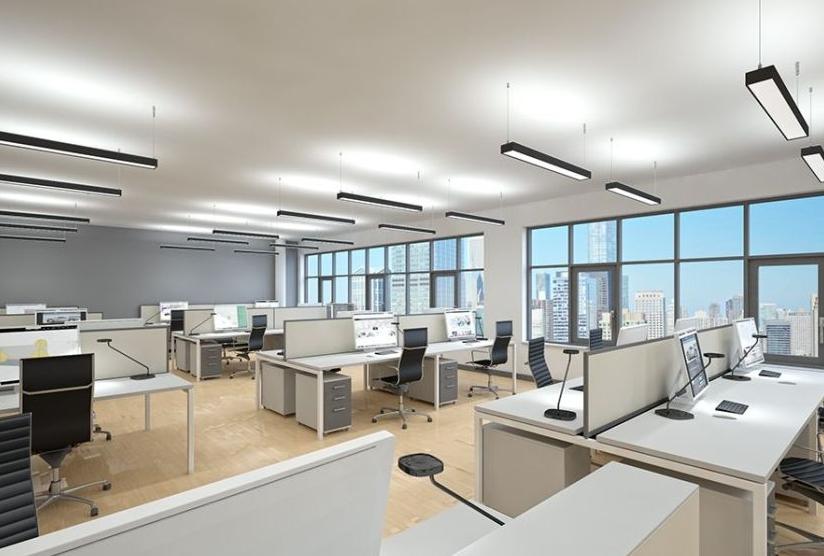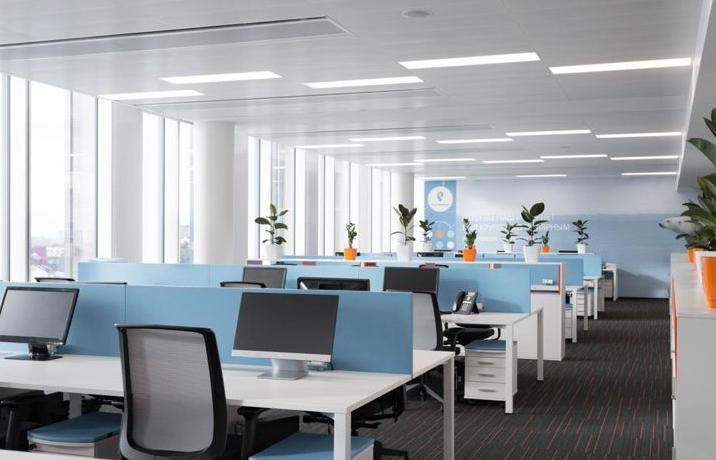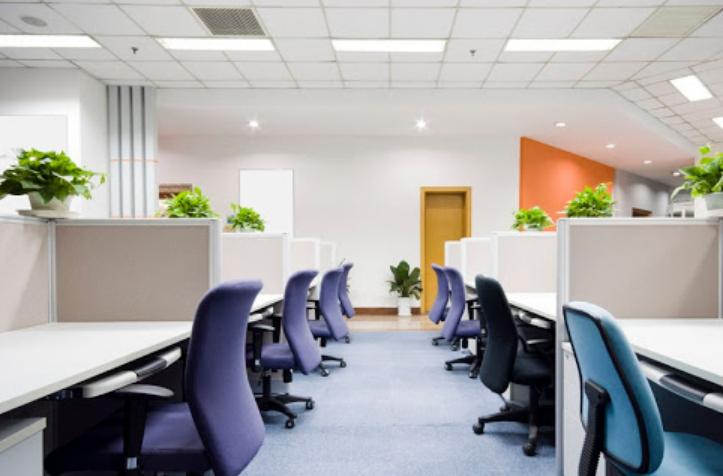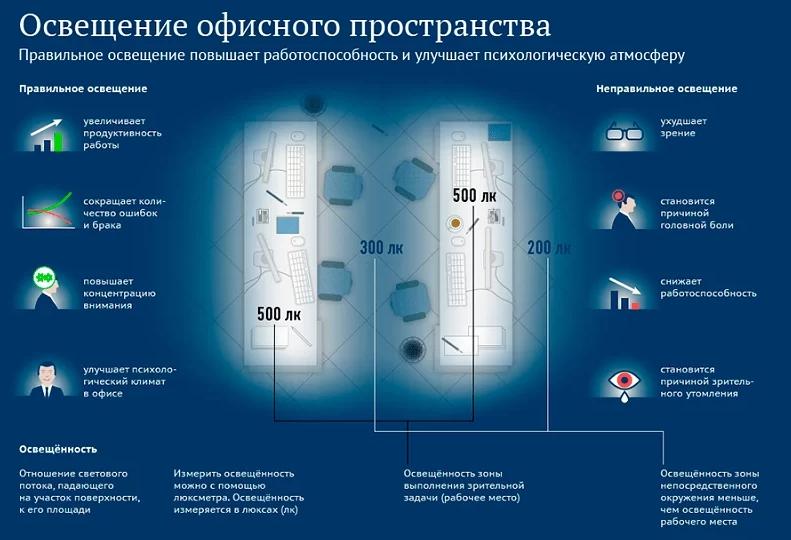Lighting requirements for office space
Office lighting is different from other places because it is a place where people do a lot of work that requires visual stress. All indicators are regulated by sanitary and hygienic standards, violations are not allowed. If the light does not meet the requirements, employees will get tired much faster and productivity will decrease.

Features of office lighting
If we proceed from the regulations, you can use different solutions for lighting in the office. But the main ones are always the same and are used almost everywhere:
- General lighting. Can be implemented by using ceiling or wall lights, it is allowed to combine the two options in one room. The equipment should give a uniform bright light, which is distributed throughout the room so that all segments where employees are placed are illuminated. Very often this is enough to provide the right indicators.
- Local or local lighting - an additional option used in addition to the main, its cannot be applied as the only. Most often installed at each workstation, it is a tabletop or mounted on the edge table top, although there can also be a wall-mounted version. For right-handed people it is better to place the light source on the left, and for left-handed people - on the contrary.If the general lighting is good, there is no need to put lights on the tables.
- Zonal lighting is needed to highlight certain parts of the room. For example, this option is often used in recreational areas, meeting rooms and other places where you need to create a special environment. Often these solutions have more of a decorative function, emphasizing the corporate style of the company or creating an area in which you can rest and relax.
- Other mandatory types of lighting should not be overlooked. You might need duty lighting when the office is not in use, security for protection against intruders, and evacuation lightingThe lighting in the corridors and auxiliary rooms must also comply with the regulations.
The lighting of corridors and auxiliary rooms should not be forgotten, it must also comply with the regulations.
Lighting standards
To choose the optimal values, you should use SP 52.13330.2016 "Natural and artificial lighting", this document has all the data, the main ones are as follows:
- For rooms with computers, the norm of illumination should be 200 to 300 lux.
- Offices of large area with a large number of employees require illumination not less than 400 lux.
- If the department deals with drawings, the norm increases up to 500 lux.
- For meeting and conference rooms the minimum values should not be less than 200 lux.
- In storerooms and auxiliary rooms norm is 50 lux.
- Lighting required in halls and corridors 50 to 75 lux.
- For archives and other document storage areas the following illumination should be provided 75 lux.
- If there are stairs and escalators in the building, these areas should have 50 to 100 lux.
Lighting for office space is checked at a height of 80 to 100 cm, which corresponds to the level of the desk. At the same time, the set values should be within 50 cm of the workplace. If the office is carried out high-precision work or require constant visual tension, the standards of illumination may be even higher, they are set by industry acts.
What to consider when calculating workplace lighting
The easiest way to calculate the required indicator with the help of a special program, in which you need to enter all the data. But you can also do it yourself, if you follow the simple instructions:
- To begin with, select the illumination standard for the workplace and multiply it by the office area in square meters. Then you need to specify the safety factor, showing the deterioration of light from luminaires over time due to dusting or clouding (for LEDs, the indicator is 1). Another indicator is a correction factor, if there are special requirements for illumination. All figures are multiplied.
- You will also need an index of utilization luminous flux in the room, which takes into account the reflection coefficient of surfaces. It should be multiplied by the number of fixtures and the number of lamps in each lamp. Then the result of the first point divided by the figure of the second.

You can involve experts in the calculations to exclude any errors and inaccuracies. If the work is done independently, it is worth taking into account the reflection coefficient of surfaces, it affects both the overall illumination and the creation of a comfortable environment in the room. For the floor it should be 0.1-0.4, for walls - 0.3 to 0.5, for ceilings - 0.6 to 0.8, and work surfaces should reflect light in the range from 0.2 to 0.7.
Natural lighting in offices
This option is the most preferred, as it provides ideal office lighting - daylight can be sufficient for most of the day and at the same time it is completely free. To determine the figures use the KEO - natural light factor, which shows the amount of light in the office compared to the light outdoors.
The natural light factor depends directly on the number of window openings and their size. The larger they are, the better the light penetration, but also the increased heat loss in winter. This is why calculations are always made to find the optimal ratio of window openings to the total wall area.

With side-to-side natural light IEO should be 1.0, and if the windows are in the ceiling slab, the index increases to 3.0. If combined lighting is used, the minimum lateral illumination value is 0.6 and the top illumination value is 1.8.
IEO figures differ from region to region. So, if in the middle and northern latitudes used coefficient of 1.0, in the south it must be increased to 1.2.
Choice of fixtures and their placement
There are several basic types of lighting fixtures that can be put in the office, each has its own characteristics. It is necessary to select the equipment in terms of power and quantity only after making calculations.
Types of lamps used
Today use different types, but the best approach is the last of the options discussed, it is worth to pay primary attention. The features are as follows:
- Incandescent bulbs are the most inefficient solution, consuming the most electricity, with a life of only 1000 hours, so you need to change the elements often. The filament gives a yellowish light of low brightness, to provide quality lighting you need to put a lot of bulbs, and this is a high electricity costs.
- Halogen bulbs Have a quality of light that provides comfortable operation. But the elements are also very hot and consume a lot of electricity. The service life is not very long, so the option is not suitable for working lighting.
- Gas discharge lamps used to be used frequently, but have now lost relevance because of the high consumption of electricity. They also give flickering light, which makes eyesight tired over time and reduces efficiency.
- LED bulbs have the longest lifespan - 50,000 hours and more. At the same time they can give light of any intensity, and the flicker rate is less than 1%. This is the best solution for the office today, which is used most often.LED lights not only provide good light, but also look modern.
- Fluorescent variants economically consume energy and do not warm up when working, but they also have a drawback in the form of flicker. In general, they are better suited than any type described above.
It is better to use the same type of equipment in the office.
Lighting requirements
First of all, you should choose the color temperature according to SNIP and sanitary norms. There is no point in going into detail, you can remember a simple recommendation - the lighting should be as close to natural as possible, it is the best option for work.
As for the location of the lights, they are placed in rows parallel to the wall with windows. It is desirable that the desks are placed between the rows, then it will provide good visibility. The light should be diffused or directed, so it does not create visual discomfort.
Topical video:
If you understand the norms, it is not difficult to pick up lighting for the office in compliance with all health regulations. LED lights are best, as they consume little electricity and do not flicker when they work.


